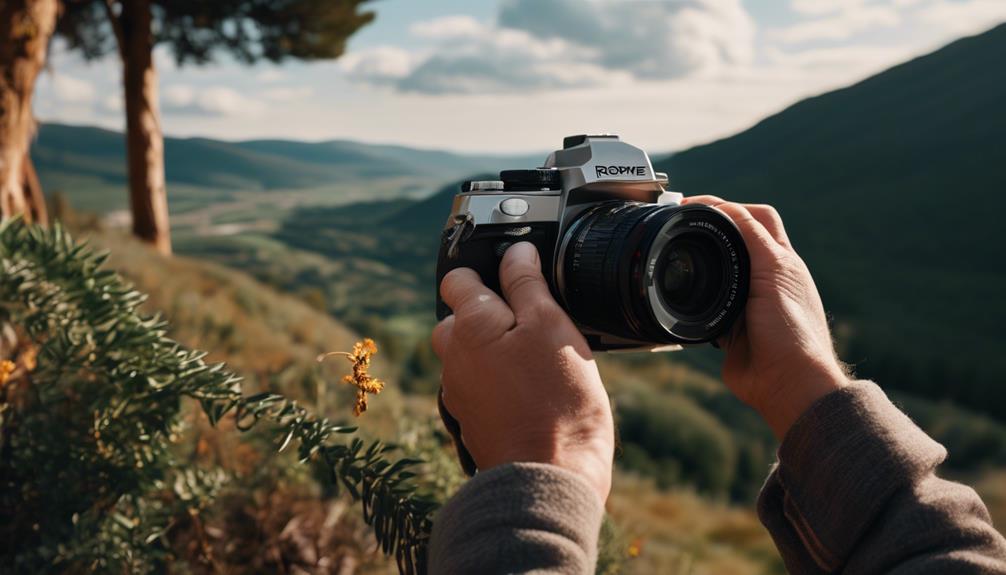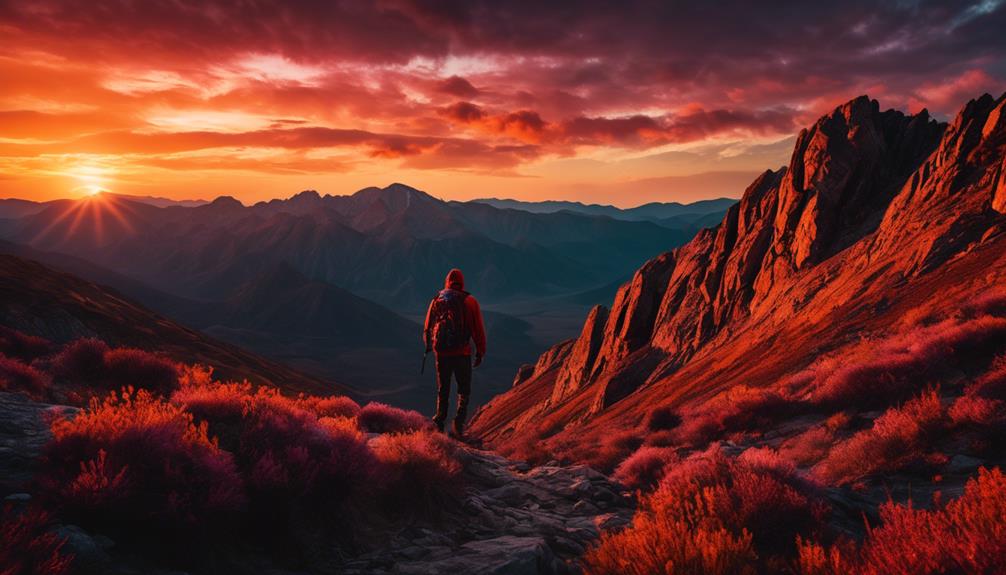Please note this post may contain affiliate links picked by me (Jay) that I have deemed may be of interest or relevant to you the reader of this.
These links do not affect the cost of the thing if you decide to purchase but i may get a little money if you choose to purchase.
For more information on my affiliate link policy click here.
As a newbie photographer, I've often found myself torn between the excitement of capturing breathtaking moments and the frustration of not knowing how to compose and frame my shots effectively.
But fear not, fellow shutterbugs, for I have discovered the 5 best tips that will transform your photographs from amateur snapshots to stunning works of art.
These tips will not only help you create visually appealing images, but also convey your intended message with clarity and precision.
So, if you're ready to take your photography game to the next level, join me on this journey of mastering composition and framing.
Key Takeaways
- The use of the rule of thirds, leading lines, symmetry, and balance can greatly enhance the composition of a photograph.
- Framing techniques such as the golden ratio, negative space, and frames within frames can add interest and focus to the subject.
- Incorporating the rule of thirds and leading lines can create depth and visual interest in a photograph.
- Experimentation with different angles, perspectives, framing techniques, and compositions is key to developing creativity and capturing unique shots.
Rule of Thirds
When I first started learning about photography, one of the first composition techniques that caught my attention was the Rule of Thirds. This technique is a game-changer when it comes to creating visually appealing and balanced photographs.
The Rule of Thirds involves dividing the frame into a 3×3 grid, both horizontally and vertically, creating nine equal parts. The idea is to place your subject or focal point along these gridlines or at their intersections, rather than in the center of the frame.
By adhering to the Rule of Thirds, you can add depth, interest, and dynamism to your photos. Placing your subject off-center creates what's known as negative space, which helps draw the viewer's attention to the subject and allows them to appreciate the surrounding elements. This technique also promotes balance and harmony in your composition, as it prevents the subject from overpowering the entire frame.
The Rule of Thirds may seem simple, but it has a profound impact on the overall aesthetics of your photographs. It encourages you to think creatively and experiment with different perspectives.
Leading Lines
Leading lines are a powerful compositional tool that can guide the viewer's eye through your photograph, creating a sense of depth and visual interest. When it comes to landscapes, leading lines can add a dynamic element to your images. Think about using roads, rivers, or fences that stretch into the distance, drawing the viewer's attention and creating a sense of depth. These lines can help to create a strong focal point or lead the viewer's eye towards a specific subject within the frame, adding a sense of narrative to your image.
In architecture photography, leading lines can be found in the form of staircases, hallways, or even the lines of a building's facade. These lines can help to create a sense of symmetry, balance, and structure in your images. By using leading lines in architecture photography, you can guide the viewer's eye towards the significant elements of the building, highlighting its unique features and showcasing its design.
Experimenting with different angles and perspectives can also enhance the impact of leading lines in your photographs. By getting low to the ground or finding a higher vantage point, you can create more dynamic and engaging compositions. Remember, leading lines aren't just limited to straight lines. Curved lines, such as winding paths or archways, can also be used to add interest and guide the viewer's eye.
Framing Techniques
To create visually compelling photographs, mastering framing techniques is essential for newbie photographers. Framing is a powerful tool that can transform an ordinary image into a captivating work of art. Here are some techniques that will take your photography to the next level:
- Golden ratio: The golden ratio is a mathematical concept that helps create aesthetically pleasing compositions. By placing your subject along the imaginary lines and intersections, you can achieve a sense of balance and harmony in your photographs.
- Framing with negative space: Negative space refers to the empty areas surrounding your subject. By using negative space effectively, you can draw attention to your subject and create a sense of depth and simplicity in your images.
- Leading lines: Leading lines are elements in a photograph that guide the viewer's eye towards the main subject. By using natural or man-made lines, such as roads, fences, or rivers, you can create a sense of depth and movement in your images.
- Frames within frames: Look for natural frames within your environment, such as archways, windows, or trees. These frames can add a layer of depth to your images and draw attention to your subject.
Symmetry and Balance
Symmetry and balance are fundamental principles in photography that can bring a sense of harmony and visual appeal to your images. When it comes to creating visually compelling photographs, understanding how to achieve symmetry and balance is crucial. These techniques help to create a sense of order and equilibrium in your composition, making your images more engaging and captivating to the viewer.
One important aspect of symmetry and balance is visual weight. Visual weight refers to the perceived heaviness or importance of elements within a photograph. By strategically placing objects or subjects with different visual weights, you can create a balanced composition that draws the viewer's attention to the right places.
Another key element to consider is negative space. Negative space is the empty area surrounding your main subject. It provides breathing room and allows the viewer's eye to rest. By incorporating negative space in your composition, you can create a sense of balance and emphasize the main subject, making it stand out even more.
To achieve symmetry and balance in your photographs, experiment with different compositions, angles, and perspectives. Pay attention to the visual weight of your subjects and use negative space to enhance your composition. By mastering these techniques, you'll be able to create visually stunning images that evoke a sense of harmony and captivate your audience.
Point of View
Now that we've explored the importance of symmetry and balance in photography, let's shift our focus to the next crucial aspect: point of view. The point of view you choose can completely transform the impact and storytelling of your photograph. Here are some tips to help you experiment with different angles and perspectives:
- Low Angle: Get down on the ground and shoot from a low angle to add drama and power to your subject. This angle works particularly well for capturing tall buildings, towering trees, or even a person's portrait, making them appear larger than life.
- High Angle: On the other hand, shooting from a high angle can give a unique and interesting perspective to your photographs. By shooting from above, you can create a sense of vulnerability or make your subject appear smaller in the frame. This angle is perfect for capturing landscapes, crowded spaces, or even group photos.
- Experiment with Different Heights: Don't limit yourself to just low and high angles. Try shooting from different heights to find the perfect point of view for your subject. Whether it's kneeling down, standing on a chair, or even climbing a tree, changing your height can offer fresh and innovative perspectives.
- Consider the Background: When choosing your point of view, pay attention to the background. Make sure it complements your subject and doesn't distract from the main focus of your photograph. By selecting the right angle, you can control what appears in the frame and create a harmonious composition.
Frequently Asked Questions
What Are Some Common Mistakes to Avoid When Using the Rule of Thirds in Photography?
When it comes to the rule of thirds in photography, there are some common mistakes that newbie photographers should avoid.
One mistake is placing the subject directly in the center of the frame, which can make the composition feel static and uninteresting.
Another mistake is neglecting to consider the background and how it interacts with the subject.
How Can I Effectively Use Leading Lines to Draw Attention to My Subject?
When it comes to drawing attention to your subject, using diagonal lines can create dynamic compositions that really make an impact on the viewer's gaze.
Leading lines are a powerful tool in photography, guiding the viewer's eyes towards the main subject and creating a sense of depth and movement.
By strategically placing these lines in your frame, you can create visually stunning images that capture the viewer's attention and leave a lasting impression.
It's all about using these lines to tell a story and create a sense of visual excitement.
Are There Any Unconventional Framing Techniques That Can Add Creativity to My Photographs?
Are there any unconventional framing techniques that can add creativity to my photographs? Absolutely!
When it comes to composition ideas, thinking outside the box can lead to stunning results. Experiment with unique angles, like shooting from a low perspective or capturing reflections.
Play with framing your subject in unexpected ways, such as using natural elements like tree branches or architectural structures.
Don't be afraid to break the rules and let your creativity run wild. The possibilities are endless when it comes to adding that extra touch of innovation to your photos.
What Are Some Tips for Achieving Symmetry and Balance in Composition?
To achieve symmetry and balance in composition, I've a couple of tips that might help you.
First, try using negative space creatively. By leaving empty spaces in your frame, you can create a sense of harmony and make your subject stand out.
Second, utilize the rule of odds. Instead of placing an even number of objects in your shot, try using an odd number. This can add visual interest and create a more balanced composition.
How Does Point of View Impact the Overall Composition of a Photograph?
Different camera angles and the importance of perspective greatly impact the overall composition of a photograph. By changing the point of view, you can create unique and captivating images.
For example, shooting from a low angle can make the subject appear more powerful or imposing, while shooting from a high angle can create a sense of vulnerability.
These different perspectives allow you to tell a story and evoke emotion through your photographs, making them more dynamic and engaging.
Conclusion
In conclusion, composition and framing are essential skills for photographers, whether you're a newbie or a seasoned pro. By following the rule of thirds, using leading lines, employing framing techniques, embracing symmetry and balance, and exploring different points of view, you can create visually stunning photographs that evoke a range of emotions.
So grab your camera, get out there, and let your creativity shine through your lens.
Happy shooting!


